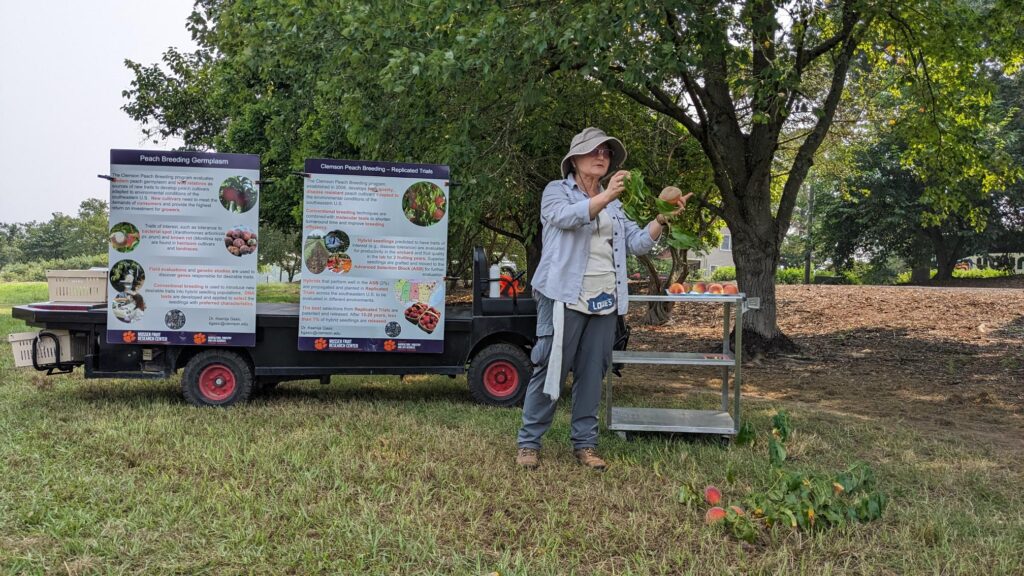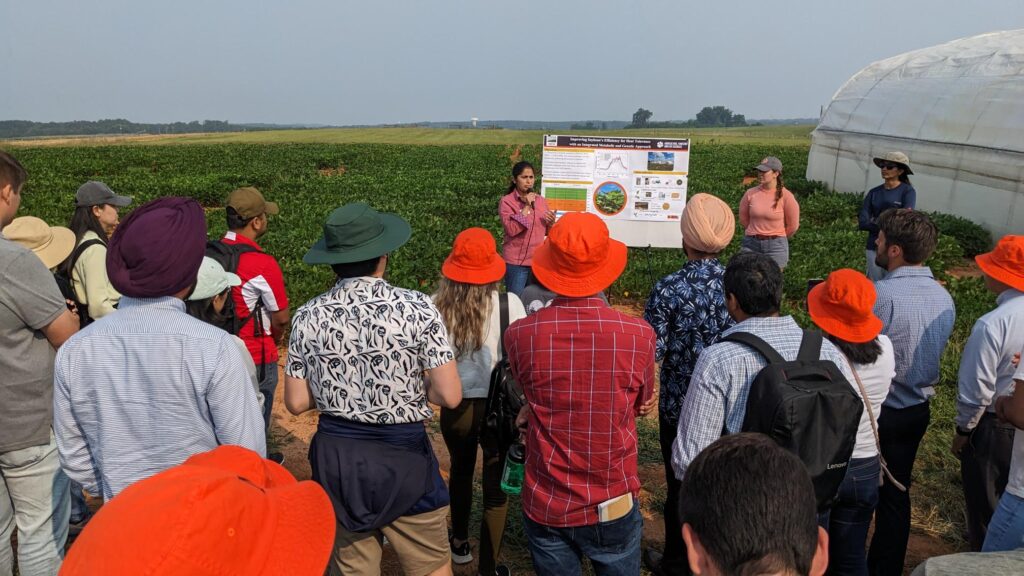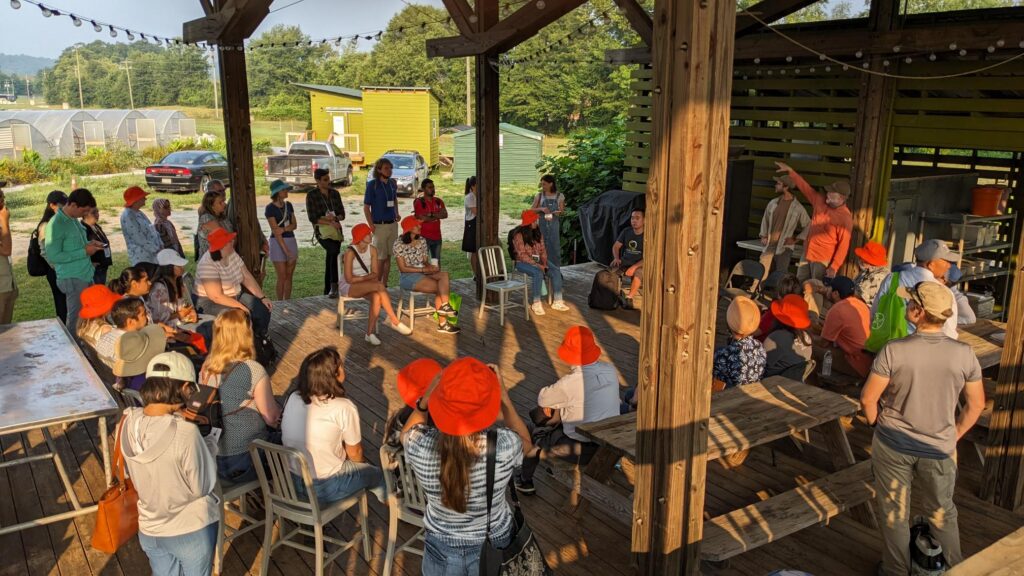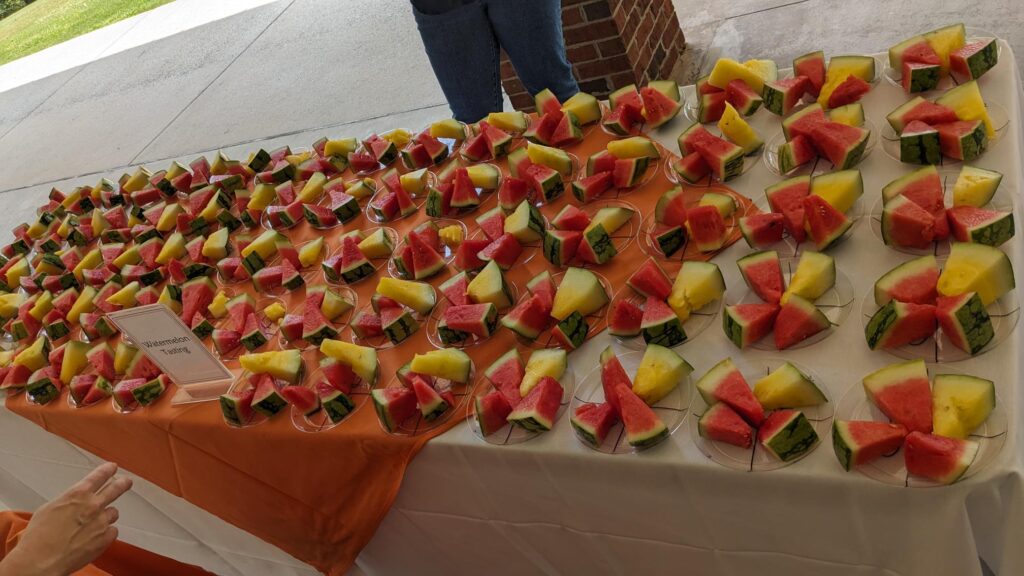Greenville, South Carolina, USA
August 14, 2023
As the brightest minds in plant genetics met in Greenville for the National Association of Plant Breeders (NAPB) annual conference July 16-20 — hosted by Clemson University — the news headlines included:
“Is climate change to blame for 2023 record heat?” USA Today.
“Extreme summer heat will become the new normal,” Financial Times.
“From searing heat’s climbing death toll to storms’ raging floodwaters, extreme summer weather not letting up,” CBS News.
Clemson University peach geneticist Ksenija Gasic, who chaired the NAPB conference organizing committee, didn’t need to read the headlines to know that something strange was in the air — literally.
As she stood behind tables with trays of cut peaches at the Clemson University Musser Fruit Research Center, the plant breeders tasted different peach varieties.
 Peach breeder Ksenija Gasic explained the reasons for the paucity of peaches this summer.
Peach breeder Ksenija Gasic explained the reasons for the paucity of peaches this summer.
In a normal year, the Musser Farm’s peach research trees would have been sagging with fruit. But not this July. The peaches they were tasting were the few available.
Instead Gasic told the national crowd of plant geneticists, who had come from as far away as Hawaii, the sad story of this summer’s peach scarcity.
“The peaches bloomed too early, one month earlier than normal, which meant that the fruits were developed and more advanced by the time the late frost hit. That’s why Georgia had 90% of its production wiped out. South Carolina’s peaches weren’t quite as developed as Georgia’s when the late frost hit. That’s why we lost only 50% by comparison,” Gasic said.
She was describing one of many problems plant geneticists are trying to tackle. Add to unseasonable temperatures, drought, flooding, disease, pests and a growing global population that will require farmers to grow more food on less land with more efficiency, and it’s enough to, well, as one headline stated: “Summer heat can lead to summer depression.”
Musser is part of an interconnected network of farms conducting research to improve livestock, agronomic, and fruit and vegetable production known as the Piedmont Research and Education Center. The Piedmont REC is one of six Clemson research farms located throughout the state collectively committed to diverse areas of research, such as improving crop yields by developing plants that are heat and drought tolerant to designing drones, sensors, and computer software to precisely apply irrigation, fertilizer and pesticides.
During the NAPB’s tour of Clemson’s Piedmont REC, the scientists witnessed firsthand the myriad ways that Clemson is working to help farmers sustainably grow more food with less inputs, more efficiently.
Gasic is part of a collaborative group of scientists known as the Clemson University Peach Team that supports the South Carolina Peach Industry by developing and testing peach varieties that can fight disease and pests, and even help reduce harvest costs.
Juan Carlos Melgar, another Peach Team member, is working on a method that was first developed at Washington State University and uses cellulose nanocrystals to insulate buds against frost damage. Melgar’s study focuses on the fruitlets, or small fruits, that appear after pollination. The nanocrystals are applied during early spring when cold snaps can occur and damage fruitlets.
“Fruitlets are coated with these nanocrystals,” Melgar said. “The nanocrystals act as tiny baby blankets, protective layers, that shield fruitlets from frost.”
Professor emeritus Greg Reighard can be considered the grandfather of peach research at Clemson University and in South Carolina. Reighard developed the Guardian® peach rootstock, which was instrumental in saving Southern peach production from disease and used the proceeds to develop the research program at Musser. Reighard showed off dwarf peach trees he is developing that will lower labor costs by making the peaches easier and faster to harvest.
The plant breeders also toured Clemson’s Simpson Station and Restoration Agriculture Farm.
At the Simpson Station, associate professor Sruthi Kutty, presented her efforts to breed soybeans that are heat and drought tolerant.
 Clemson plant geneticist Sruthi Kutty showed off her research into drought-resistant soybeans.
Clemson plant geneticist Sruthi Kutty showed off her research into drought-resistant soybeans.
“We have found novel lipid metabolic traits associated with heat tolerance in soybean and the genes controlling those traits,” Kutty said. “These genes can lead to the identification of molecular markers that will be useful for selecting for heat-tolerant soybean genotypes.”
Clemson plant geneticist Rick Boyles’ research into sorghum production aims to create an entirely new crop market in South Carolina and Southeast.
Sorghum grain, which is used to feed livestock, is currently grown primarily in Kansas, Texas, Colorado, Oklahoma, Nebraska and South Dakota, but Boyles sees an opportunity to grow it in the Palmetto State and other southern locations where it can be used to feed livestock in the south’s prodigious animal agriculture industry.
At Clemson’s Restoration Agriculture Farm, located at the Laboratory at the Seneca Bottoms, the scientists saw firsthand a demonstration of climate smart agriculture, regenerative organic agriculture and restoration agriculture.
The farm demonstrates the use of berms and swales to protect crops from flooding and the ecological restoration of farmland by planting a mix of trees and shrubs to mimic natural oak-pine forests.
Seed history and the impact of plant genetics
Back in downtown Greenville, the conference epicenter, plant breeders were accompanied by chefs, agricultural historians, seedsmen and even a renowned food writer, where the theme of the conference, “Southern hospitality through food and agriculture,” was in full swing.
Lowcountry chef Benjamin “B.J.” Dennis traces his South Carolina ancestry as far back as ten generations and is known throughout the Southeast for paying homage to his Gullah Geechee roots by infusing his cooking with the techniques and ingredients of his culture. But Dennis is concerned about the impact of sea level rise and saltwater intrusion on the growing conditions in the Lowcountry.
 Plant breeders gathered at Clemson’s restoration agriculture farm.
Plant breeders gathered at Clemson’s restoration agriculture farm.
He talked about okra crops being flooded by saltwater and the need to collect seeds from the few plants that survived to breed more okra that can resist saltwater stress.
“You know, on the coast right now we’re dealing with salt, we’re dealing with rising sea levels and the rampant tearing up of our barrier islands and rapid development of the marshland. What’s going to happen? What’s needed? We need seeds that will deal with water and salt tolerance,” he said.
Dennis also hopes to create a cooperative kitchen where farmers can bring in excess product and it can be converted into food for the local community.
“What does that mean? A lot of these farmers have so much product. This time of year, we have so much okra and a lot of people don’t like okra. A lot of times it’s in the field going bad. So, what does that mean? It means we can take that okra, put it in my space, which will be a kind of cooperative kitchen, and we can make products with the okra. And like we say, we use nose to tail for food. We can use the whole plant,” Dennis said.
Glen Roberts is the founder of Anson Mills, a Columbia mill that helped bring back Carolina Gold Rice and produces and mills fresh native stone-ground organic ingredients from new crop heirloom grains, legumes, and oil seeds.
Roberts spoke about the role forced and voluntary migration played in the spreading of seeds and the early development of agriculture, which still echoes today in the Lowcountry islands, the unsuspecting gardens of the coastal African American landowners, and the products we find on the grocery store shelves. He recalled meeting the ancestors of families who made their fortunes from the seeds and growing techniques that were passed on through generations from enslaved Africans.
“Post, Kellogg, Quaker and others. Why did they all have research here? They don’t anymore, but they used to. Why? Because the genetics were here. The seed was here and the expertise to replicate that seed,” said Roberts.
He urged the geneticists to develop rice that can go from seed to harvest in 40 days or less to give the crop a greater chance to survive increasingly hostile growing conditions.
“Why do I need that? Because we need to get it out of the field fast. Last year I had a flood and a wildfire in my rice fields concurrently. A flood and a wildfire. So, I want stuff fast. I want rice that matures at 40 days. How many of you are working on that? Would you hurry please,” Roberts said.
Sandra Branham, assistant professor of vegetable breeding and genetics at Clemson University’s Coastal Research and Education Center, provided an overview of her progress in establishing a vegetable breeding program at Clemson University that will develop plants for heat tolerance and disease resistance.
“Stakeholder driven research at the Charleston REC continues today and drives how I think about plant breeding. I’m here to try to solve problems for growers in the Southeast.”
Clemson plant geneticist Sandra branham
One of Branham’s programs, CucCAP, tries to use applied genomics to incorporate disease resistance in cucurbits. Branham is leading an effort to develop resistance to fusarium wilt in watermelons.
 Plant breeders were asked to taste and rate watermelon varieties for flavor and texture.
Plant breeders were asked to taste and rate watermelon varieties for flavor and texture.
Branham’s team looked to a wild crop relative of watermelon to find a resistant gene and began to move that resistance into cultivated watermelons. They found that resistance to fusarium wilt in the test watermelons was higher.
Branham’s program is also trying to develop bacterial blight resistance in turnip greens and spinach.
“Brassica leafy green production is really important to the Southeast and South Carolina in particular. South Carolina and Georgia rank first and second in the Southeast in production. This disease infects all brassicas and there are currently no chemical management options. You can get total crop loss with this pathogen,” Branham said.
Branham and her team assessed over 1,000 brassica cultivars for bacterial blight resistance and found a turnip green variety that has the most resistance. Her team crossed the resistant strain into a brassica cultivar that is extremely sensitive to disease.
During the breeding process, Branham brought in growers to select for horticultural characteristics.
“I brought in the largest producer of fresh market turnip greens, the biggest producer of processor greens and the actual processor and invited them to make single plant selections. I’ve done this 2 years in a row,” Branham said.
Input from chefs and growers is key
The adage from the movie Field of Dreams, “If you build it, they will come,” doesn’t work anymore in the plant breeding world. The scientists are now including growers, chefs and consumers in the plant breeding process to ensure that they are breeding for characteristics that are desirable to the growers and markets.
USDA research geneticist Lisa Kissing Kucek presented case studies in participatory breeding cover crops and wheat for organic and local arm systems. In each case, she developed a network of farmers to assist in variety selection.
Lane Selman, Professor of Practice at Oregon State University, manages the marketing and public outreach activities for participatory research projects with organic farmers. In 2011, Selman created the Culinary Breeding Network to build communities of plant breeders, seed growers, farmers, produce buyers, chefs and other stakeholders to improve quality in vegetables and grains.
“We focus on trialing on organic farms, breeding lines, as well as new varieties and commercially available cultivars that were already in the marketplace, and that people were growing. So, to compare them across a lot of different environments and see how they perform, we worked on a lot of different crops,” Selman said.
One of those crops is peppers.
Selman held a chef’s tasting of nine commercially available pepper cultivars. She also asked to evaluate them for texture. The chef’s narrowed the selection down to five peppers but they favored one particularly not only because of taste and texture but also because of size and shape which would make it easy to work with in the kitchen.
“So, it cooks very evenly, and it has these nice, rounded shoulders. If you can imagine if you had hundreds of these and you’re in a restaurant situation, you have to process all of them. There’s less waste and it’s faster to process and it cooks more evenly — complete no-brainer. But, you know, this was the moment for me where I was like, aha. ‘Like wow, those are very important traits,’” Selman said.
Michael Mazourek, the Calvin Knoyes Keeney Associate Professor of Vegetable Breeding at Cornell University, talked about the importance of collecting input from everyone during the plant-breeding process and using tastings to choose what varieties carry forward, and challenging new commodities to be unique.
“I found myself breeding varieties that weren’t going to be a fit in the market because I wasn’t spending enough time listening to what the market needed. Now I spend a lot of time creating new things that satisfy what they are looking for and making sure it’s distinct,” Mazourek said.
Julie Dawson, associate professor in the Department of Plant and Agroecosystem Sciences at the University of Wisconsin-Madison, directs the Seed to Kitchen Collaborative.
The collaborative connects plant breeders focused on organic systems to Wisconsin farmers and chefs to create vegetable varieties for local organic production. She works with direct market growers who sell vegetable and grains to the regional food systems.
“We are seeing an increase in consumers who want to buy their food locally. Farmers are looking for increased variety to satisfy local food markets and they want to support new ways of doing research that engage multiple stakeholders, rather than treating plant breeding as separate from the other pieces” Dawson said.
Dawson started by setting trials on a university research station, testing them with chefs, and then sending the varieties that were most favorably received to farmers. The program has grown from a handful of farmers in 2013 to over one-hundred farmers who are testing different sets of varieties.
“We were able to identify varieties that work will in the Midwest and about 68% of farmers said they had identified a new variety that they were using because of the trials,” Dawson said.
Solveig Hanson, a research support specialist at Cornell University, undertook a systematic study of table beet flavors to develop consumer-accepted specialty cultivars and gauge earthly flavor preference in real life conditions. Hanson used a single farm model and an outreach model where she surveyed farmers to get their preferences, and she used Dawson’s Seed Kitchen Collaborative to study consumer preferences and the winner went on to seed production.
“To increase trial completion rates, we found it was important that farmers had input into what was going to be trialed, what crops and traits were going to be emphasized in the trial. And the trials needed to fit into their very busy lives,” Hanson said.
Gene editing powers plant breeding
Innovations in plant breeding such as the use of gene editing tools are dramatically reducing the time it takes for scientists to design plants that can resist pests, disease, and drought, and help create plants that are more nutritious and palatable.
Manny Saluja has an expertise in Plant breeding and Plant Physiology and is currently leading research projects to establish genome editing technologies to support trait development and breeding programs in Maize, Cereals and Oil seed rape at KWS.
 Clemson plant geneticist Chris Saski explained his research to develop more productive cotton plants.
Clemson plant geneticist Chris Saski explained his research to develop more productive cotton plants.
“These technologies offer is the opportunity to leverage existing genetic diversity to increase the speed and efficiency of creating new varieties,” said Manny Saluja, plant geneticist for KWS Seeds.
Saluja is currently leading research projects to establish genome editing technologies to support trait development and breeding programs in maize, cereals, and oil seed.
Through gene editing technology, KWS has been able to reduce to two from seven the number of generations to create a new sunflower variety, and 20 years to 4 years the time it took to create a nematode resistant sugar beet.
Lolita Mathew of Pairwise Genetics talked about her company’s efforts to use gene editing tools to make brassica greens more palatable.
Brassica greens have greater nutritional value than lettuce but are not favored by consumers because of their pungent flavor.
By identifying and editing the gene for pungency in the greens, Pairwise was able to improve their flavor and add them to the company’s Conscious® line of products.
“We found that consumers resonate with gene edited foods if they can identify the tangible benefits of the product,” Mathews said.
Clemson University plant geneticist Chris Saski described his research into understanding genetic mechanisms in upland cotton.
Through gene analysis and editing, Saski has been able to create cotton plants with reduced branch angels.
Saski and his team analyzed the genome of wild cotton plants, which have far more acute branch angles than cultivated cotton and were able to bring this trait into upland cotton.
“Can we increase planting density and yields with altered branch angles?” Saski said.
He found that the gene edited plants had more leaf and biomass and the altered branch angles corresponded to improved light interception.
Saski also talked his cotton regeneration research, which was launched into Dec. 21, 2021, from NASA’s Kennedy Space Center for the International Space Station (ISS).
The research project titled, “Unlocking the Cotton Genome to Precision Genetics,” was conducted in microgravity with the goal of facilitating the ability to directly edit the genome of elite cotton varieties, quickly adding traits like disease resistance or drought tolerance without the need for the lengthy conventional breeding process that can take over a decade.